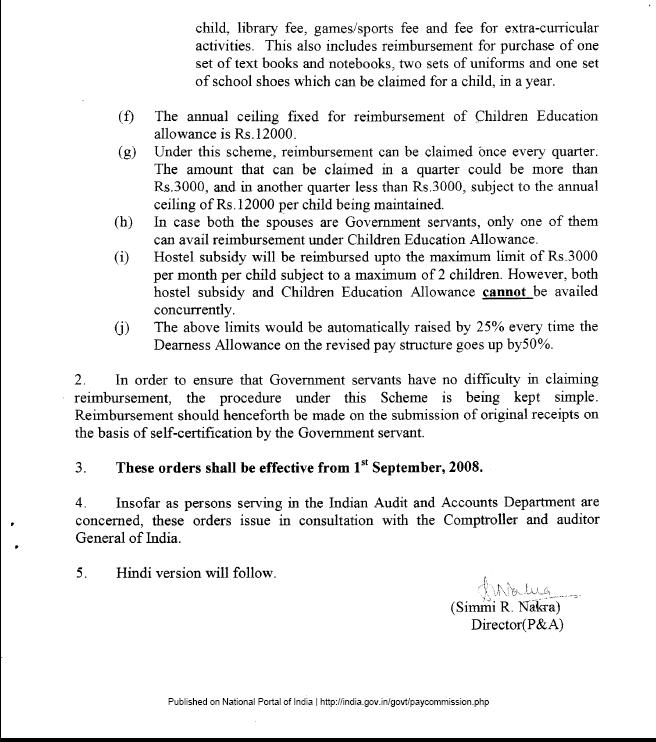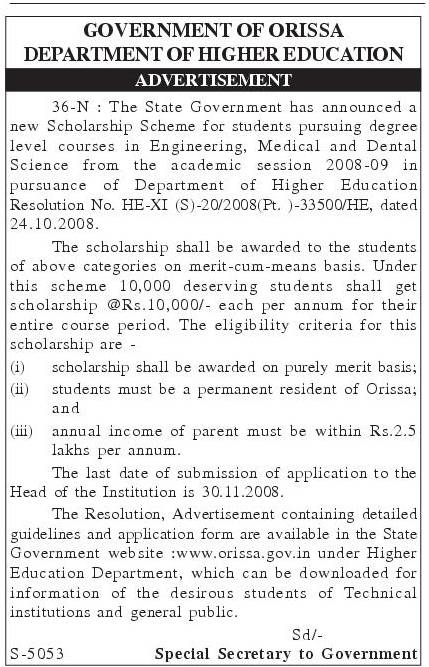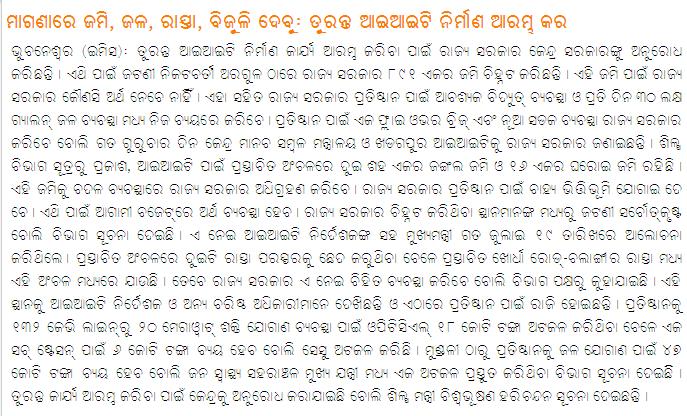Following is an excerpt from a report in Business Standard.
…XIMB had sought 60 acres of land from the Orissa government in Bhubaneswar for developing its second campus but the B-school’s plans was marred by inordinate delay on the part of the state government in allotment of land.
“We have already taken up the issue of allotment of land with the state chief minister, industries secretary and other relevant officials. However, we are yet to receive any communication from the state government on allotment of land”, Joseph clarified.
The institute was open to set up its second campus in alternative locations of the state like Cuttack and Khurda if land was unavailable in the city.
Meanwhile, it had also started scouting for private land in Cuttack and Khurda apart from within the city owing to delay in allotment of land by the state government and the B-school was aiming to take possession of the land by the end of this year.
The institute aimed to make its second campus operational by 2012 to mark the 25th year of formation of XIMB.
In another development, XIMB is set to roll out the part-time doctoral programme in management in its existing campus from the next academic session.
This programme is being designed for those work executives who cannot pursue full-time doctoral course in management.
… At present, XIMB offers Fellow Programme in Management (FPM) with an intake of 15 participants every year.
… XIMB had recently entered into a MoU (memorandum of understanding) with the US-based Eastern Michigan University for offering dual degree programmes to its students.
According to the MoU, the students of XIMB will spend two semesters at the Eastern Michigan University and they will be awarded certificates in post graduate programmes like MS degree in Information Systems and MS in Organisational Behaviour apart from the conventional MBA course.
XIMB is awaiting the approval of the All India Council for Technical Education (AICTE) for offering the dual degree programmes to its students.
With an annual intake of over 1,000 students, XIMB currently has tie-ups with ten overseas B-schools in Germany, France and Spain.
Talking to some people who are in the know, the govt. is trying to give 60 acres of land to XIMB for its second campus. The delay is due to several reasons, but the govt. is definitely trying. The possible location of this is near Naraj Mundali in the area called Ramdaspur. This is within a km or two of the Sri Sri University location. That area is slowly becoming a knowledge hub with the following proposed institutions:
- Sri Sri University, Govindpur (near Arilo), Naraj side
- National law school, Brajabiharipur, Cuttack side
- XIM Second campus, Ramdaspur, Naraj side
- Ravenshaw University second campus, Bidanasi, Cuttack side
November 4th, 2008
Following is based on recommendation of the 6th pay commission; see http://india.gov.in/govt/paycommission.php. Its effective 1st Sept 2008. As per a report in Dharitri the Orissa government is also planning to implementing it for its state employees.


The above numbers can serve as a benchmark for the state and the country to aim to provide for similar amount for every child’s K-12 education. They can start with kids with BPL parents, making it part of R & R, requiring every organization with more than 20(?) employees to provide to all their employees’ children, etc.
November 3rd, 2008
Update 2: Telegraph also reports on it.
Update: A report in Hindu has some more details. Following are some excerpts:
AIPH is starting with small programmes such as Certificate in Public Health Management. The institute would be located over a 50-acre land near Jatni, on the outskirt of the capital city. Promoters of the institute plan to invest Rs. 15 crores immediately to start the programme with the help of some guest faculties from the USA.
Speaking at the inaugural ceremony, David J. Ramsay, president of University of Maryland, said “We will build different centres of excellence under the umbrella of AIPH. I have allocated matching funds in our efforts to secure financial support for infrastructure building. Very soon, AIPH will bring US-based faculty and experts to Orissa for teach, training and conducting research.”
AIPH Secretary Pinaki Panigrahi claimed the institute would be the first of its kind as India had 209 medical colleges whereas there was no full-fledged public health school. But in USA there were 129 medical schools and 33 public health institutes, he added. “The institute will prepare workforce to help formulate and implement health programmes in the country,” Dr. Panigrahi said.
The new institute has roped in several Indian-based teaching faculties as well as US-based experts to take forward different specialized programmes in its campus.
Among others AIPH President N. K Ganguly, who was former director-general of Indian Council of Medical Research (ICMR), was present on the occasion.
Following is an excerpt from a report in Expressbuzz.com.
With disease burden not showing any signs of decline despite advancement in therapeutic sciences across the world, the focus of public health has shifted to prevention.
The future of a healthy society hinges on securing the populace from afflictions by way of inducing suitable changes in lifestyle and societal atmosphere and also, very importantly, increasing immunity through vaccination, said President of University of Maryland Baltimore, (UMB), USA, David J Ramsey today.
Ramsey told this paper that worldwide, intensive efforts are on to develop vaccines for diseases that have the greatest impact on the population and not on individuals. The UMB has already developed a vaccine for cholera, which is being successfully implemented in South American countries. Progress is being made in the efforts to formulate a vaccine for malaria, AIDS and several other prevalent diseases in the stateof- the-art facility at the University.
But the challenge lies in implementation of the interventions to check outbreaks. Public health is still not considered a different domain from medical or clinical streams in most parts of the world, particularly developing countries including India.‘‘
The realm of public health basically involves collating biostatistics, epidemiology, environmental health sciences, health services administration, and social and behavioural sciences so that prevention and treatment initiatives and policies would be well-directed and most effective,’’ the head of the prestigious institute said.
And, in an initiative aimed at strengthening the public health sector in India as well as the sub-continental countries by producing skilled professionals to carry out operational research to develop sustainable health-care delivery models, the Asian Institute of Public Health (AIPH), a partner of UMB, is set to take shape here from Sunday.
The first of its kind institute in the country, with support of the Orissa Government, would offer courses on Public Health Management, Management development programmes on ‘Surveillance, Epidemic Preparedness and Response’, ‘Biostatistics and Research Methodologies’, ‘Biomedical Waste Management and Handling’, ‘Good clinical Practice of Clinical research’ and ‘Emerging issues in public health’. The target scholars would include medical officers, AYUSH doctors, personnel from health agencies, Government health administrators, social scientists, corporate sector managers dealing with health programmes, paramedics, sanitation workers, NGOs, etc. The courses have been designed and be certified by UMB, AIPH secretary Dr Pinaki Panigrahi said.
The above articles do not mention the Indian Institutes of Public Health being built in India, three of which mention that they are offering post-graduate diploma starting fromn the 2008-09 session. Following is an excerpt.
The Indian Institutes of Public Health at Delhi, Gandhinagar, and Hyderabad would be offering the following Post Graduate Diploma (PGD) Programs in the academic year 2008-09:
| IIPH, Delhi: |
PGD in Health Economics and Policy |
| IIPH, Gandhinagar: |
PGD in Public Health Management |
| IIPH, Hyderabad: |
PGD in Biostatistics and Data Management |
If done right the AIPH can surpass the IIPHs, mainly because a well known professor Dr. Pinaki Panigrahi is behind it and his university, The University of Maryland at Baltimore, is an active collaborator on this. The Orissa govt. may take advantage of the AIPH and push for an IIPH next to it. They have discussed with PHFI, but its plan (see here and here) in Orissa is not clear.
Also, note that in the PHFI/IIPH model companies, state and the center (through PHFI) fund the IIPHs. Orissa government should help AIPH in a similar manner: contribute a similar amount, ask companies to contribute and ask the center to contribute. To get an idea of the PPP nature and the amount used to fund IIPH, following is an excerpt from a report in Hindu.
Industry leaders came forward to pump in Rs. 30 crore to make Indian Institute of Public Health (IIPH), an arm of the Public Health Foundation of India (PHFI), commence its first-ever postgraduate diploma course in biostatistics and data management from July this year.
The Union Government through PHFI had sanctioned Rs. 60 crore, while the State Government allotted 43 acres in Rajendranagar and sanctioned Rs. 30 crore for the IIPH. The new governing council assumed charge on Saturday. Addressing a press conference here, G.V. Krishna Reddy, chairman of the governing council, said he, along with G.V. Prasad of Dr. Reddy’s Labs, G. Mallikarjuna Rao of GMR Group, N. Prasad of Matrix Labs, B. Rama Raju of Satyam Group, and SriniRaju of iLabs, would together donate Rs. 30 crore.
November 2nd, 2008



